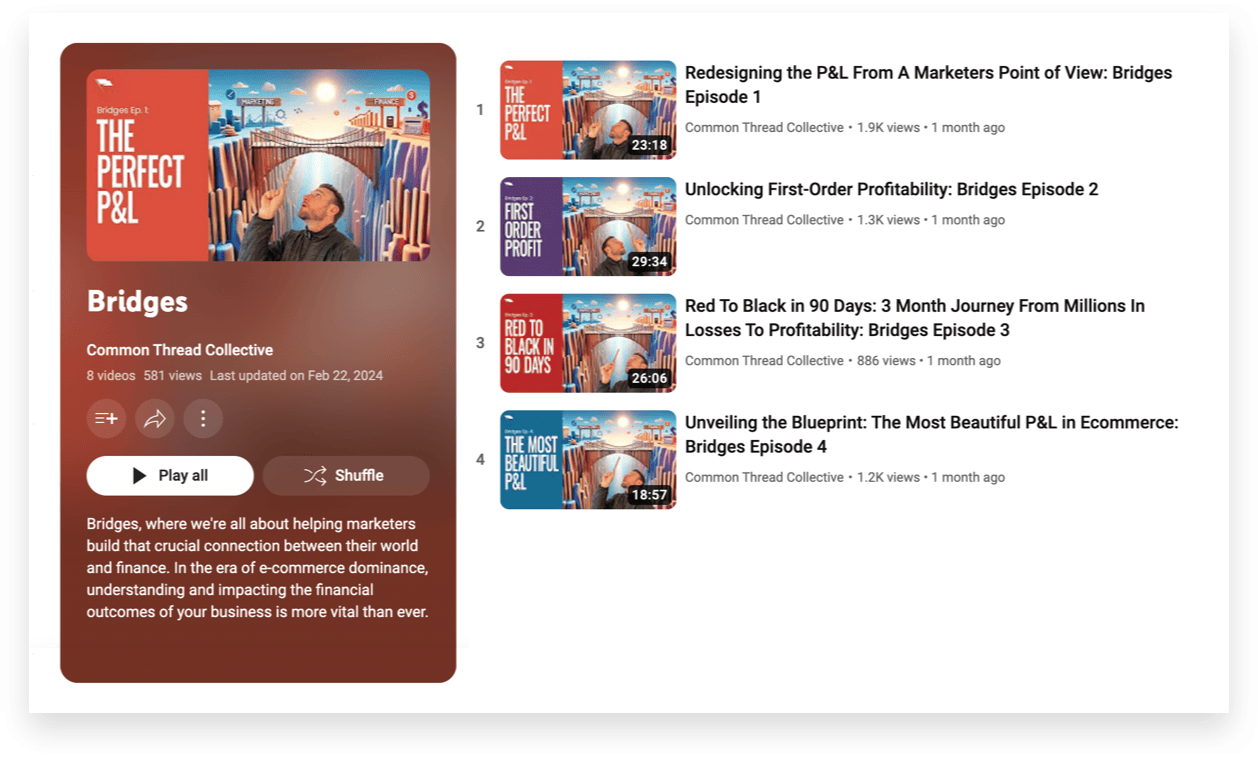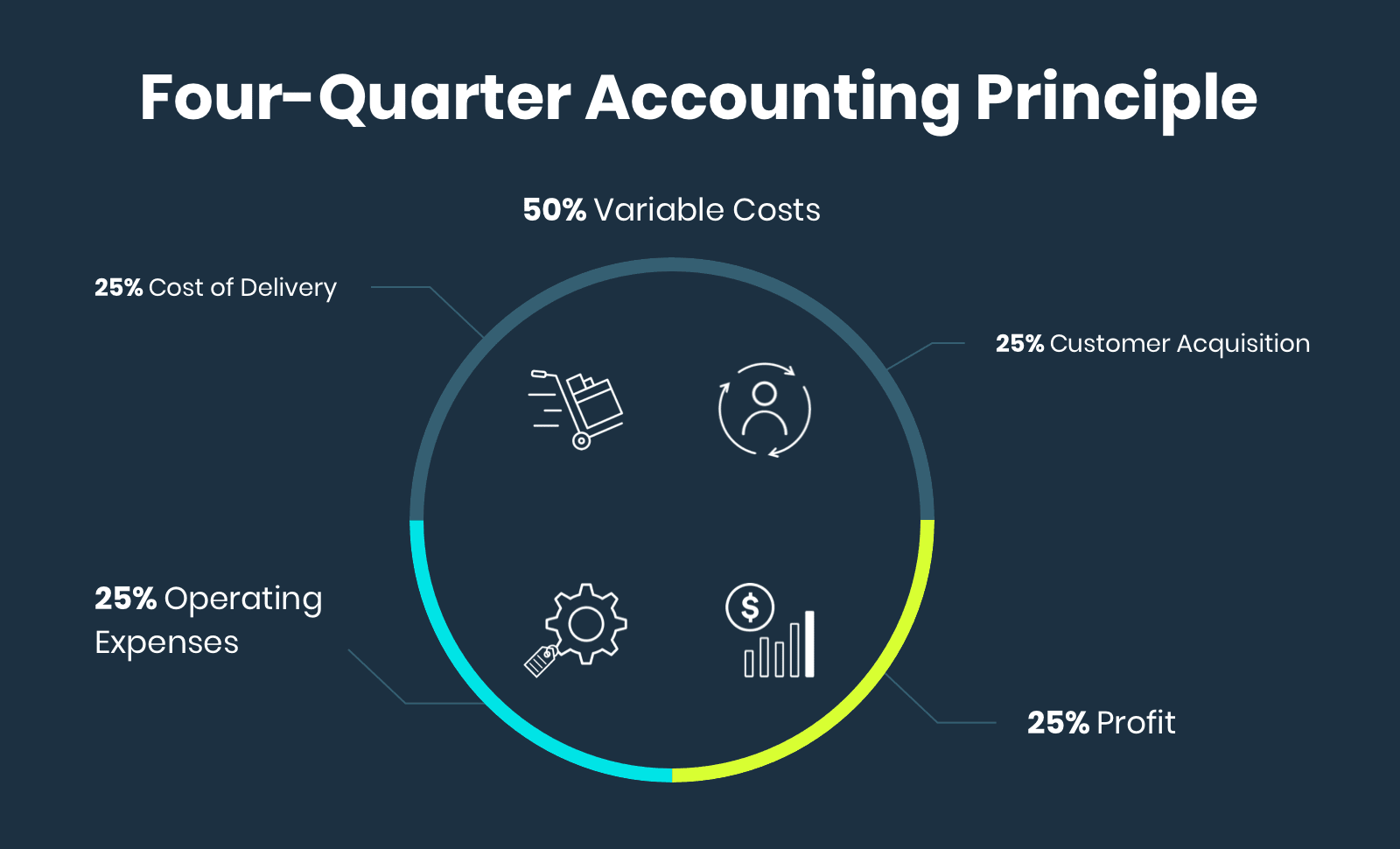Implement the Prophit System for Your Brand
We’ll work with you to custom-build CTC’s predictable, profitable growth system for your ecommerce business.
Get Started
As we navigate the complex landscape of ecommerce, two fundamental pillars often stand apart: finance and marketing. Often seen as distant cousins, these two spheres are more interconnected than we often realize. The integration of finance and marketing is not just a trend; it's a necessity in today's competitive ecommerce environment.
In this video, we explore the remarkable journey of a thriving ecommerce business, dissecting its financial performance through the lens of what we're calling "The World's Most Beautiful P&L".
But what makes this P&L truly beautiful? It's not just the numbers — it's the story behind the figures and the software that brought them to life.
Your blueprint to creating the most beautiful P&L …

This video is a part of our “Bridges” series, which aims to bridge the gap between marketing and finance.
In the current ecommerce era, understanding the financial components of a business is no longer optional for marketers; it's essential.
This shift towards financial fluency is not just a trend but a necessity.
Let's start by discussing the crucial role that accounting software plays in empowering marketers. Enter Finaloop, an accounting software designed specifically for ecommerce.
Finaloop is tailored to address the unique financial challenges faced by ecommerce businesses, providing marketers with real-time, comprehensive insights. This software also builds percentage tracking into the P&L by default, which makes it so much easier to understand for many marketers.
Let's take a closer look at the key components of this beautiful P&L.
From sales by channel, discounts, promotions, returns, and refunds, to operational expenses, every detail is meticulously organized and presented. The P&L paints a picture of a thriving ecommerce business, with sales soaring and costs controlled.
Building a profitable ecommerce operation is no easy feat, but it's not impossible.
By implementing a Four-Quarter Accounting approach and focusing on revenue generation, cost management, and operational efficiency, ecommerce businesses can achieve sustainable profitability.
Structure your P&L in a way that establishes four key categories to focus on for systemic growth.
Those four categories include:

This will give us a very quick glimpse into key areas of improvement for this brand.
To dive deeper into the overall Cost of Delivery, The two things that we care a lot about are …
Total shipping and fulfillment expenses should sit in the 10%-12% range. That might not be possible when you’re shipping something like large furniture or in categories where shipping becomes more difficult relative to fulfillment.
Operational excellence is essential for maximizing profit margins.
This involves managing operating expenses and ensuring that marketing strategies are focused and efficient. A disciplined approach to financial organization and execution can make a significant difference.
In this case, the product doesn’t see many discounts or returns … and that’s an area that hurts many similar ecommerce businesses. Without those issues, this brand is able to produce a fantastic margin.
You can have a good culture, benefits, an office, and care about your employees while keeping payroll costs at sub 10%.
Ecommerce isn’t a full-time employee business. It’s highly seasonal. You should have revenue near or above $1M per full-time employee.
Focused channels and responsibilities make maintaining output and profit with a smaller staff possible.
This business is focused. They have a clear market. They have a single channel. They don’t have a real breadth of media efforts. They know who they are and they have a team that is largely focused on customer support.
Our journey doesn't end with the P&L. It's time to challenge our perceptions and expand the bounds of possibility in ecommerce.
We'll explore how successful ecommerce businesses overcome the "local maxima problem" and maximize margins through product category, return rates, and pricing strategies.
When you only see a small data set, you begin to think that all the possibilities lie within what you’ve seen. At Common Thread Collective, we get to see so many brands at the P&L level. This broad view helps us understand the breadth of possibilities in ecommerce businesses.
In this case, our brand is generating almost $40M in revenue, 45% Net Operating Income on DTC ecommerce alone. This doesn’t represent an omnichannel approach, not distributed all over the place, this is possible with ecommerce alone.
This doesn’t simply happen from wildly efficient Meta-acquisition alone, but from generating organic demand from your audience.
We have seen this happen in multiple business categories: supplements, accessories, businesses with total OPEX below 10% (fully remote), others with total margin as low as 18%, some with CAC in the 35% range.
There is no one way to achieve this result, but you have to figure out where your leverage is.
While the P&L is an essential financial tool, it has its limitations.
We'll discuss the importance of cash flow statements and balance sheets in providing a comprehensive view of a business's financial health. We'll also preview future topics, such as understanding lending, interest rates, and inventory management.
As we conclude our exploration of the world's most beautiful P&L, we're reminded of the importance of integrating finance and marketing for ecommerce success. Ecommerce leaders must challenge their perceptions and strive for operational and financial excellence. By embracing detailed financial analysis and leveraging accounting solutions like Finaloop, businesses can transform their operations and achieve sustainable growth.
Share this blog with your peers and colleagues, and explore financial tools like Finaloop to enhance your ecommerce strategy. Engage in financial education to better integrate marketing and financial planning.

We’ll work with you to custom-build CTC’s predictable, profitable growth system for your ecommerce business.
Get StartedCommon Thread Collective is the leading source of strategy and insight serving DTC ecommerce businesses. From agency services to educational resources for eccomerce leaders and marketers, CTC is committed to helping you do your job better.
For more content like this, sign up for our newsletter, listen to our podcast, or follow us on YouTube or Twitter.